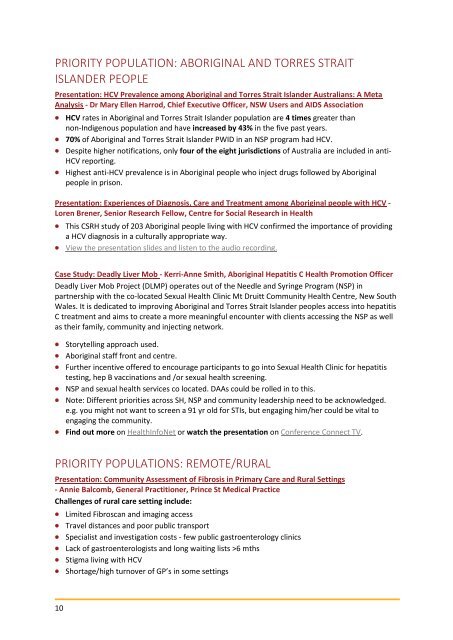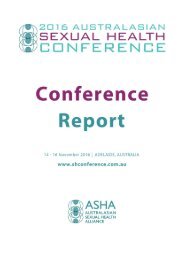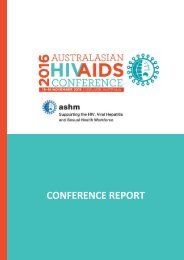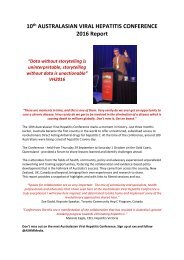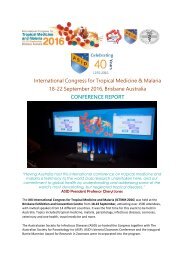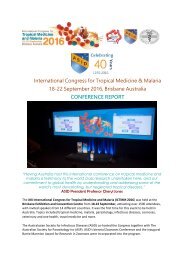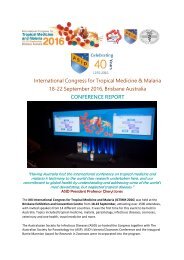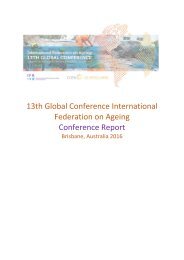ASHM_VH2016_Report_FINAL
You also want an ePaper? Increase the reach of your titles
YUMPU automatically turns print PDFs into web optimized ePapers that Google loves.
PRIORITY POPULATION: ABORIGINAL AND TORRES STRAIT<br />
ISLANDER PEOPLE<br />
Presentation: HCV Prevalence among Aboriginal and Torres Strait Islander Australians: A Meta<br />
Analysis - Dr Mary Ellen Harrod, Chief Executive Officer, NSW Users and AIDS Association<br />
• HCV rates in Aboriginal and Torres Strait Islander population are 4 times greater than<br />
non-Indigenous population and have increased by 43% in the five past years.<br />
• 70% of Aboriginal and Torres Strait Islander PWID in an NSP program had HCV.<br />
• Despite higher notifications, only four of the eight jurisdictions of Australia are included in anti-<br />
HCV reporting.<br />
• Highest anti-HCV prevalence is in Aboriginal people who inject drugs followed by Aboriginal<br />
people in prison.<br />
Presentation: Experiences of Diagnosis, Care and Treatment among Aboriginal people with HCV -<br />
Loren Brener, Senior Research Fellow, Centre for Social Research in Health<br />
• This CSRH study of 203 Aboriginal people living with HCV confirmed the importance of providing<br />
a HCV diagnosis in a culturally appropriate way.<br />
• View the presentation slides and listen to the audio recording.<br />
Case Study: Deadly Liver Mob - Kerri-Anne Smith, Aboriginal Hepatitis C Health Promotion Officer<br />
Deadly Liver Mob Project (DLMP) operates out of the Needle and Syringe Program (NSP) in<br />
partnership with the co-located Sexual Health Clinic Mt Druitt Community Health Centre, New South<br />
Wales. It is dedicated to improving Aboriginal and Torres Strait Islander peoples access into hepatitis<br />
C treatment and aims to create a more meaningful encounter with clients accessing the NSP as well<br />
as their family, community and injecting network.<br />
• Storytelling approach used.<br />
• Aboriginal staff front and centre.<br />
• Further incentive offered to encourage participants to go into Sexual Health Clinic for hepatitis<br />
testing, hep B vaccinations and /or sexual health screening.<br />
• NSP and sexual health services co located. DAAs could be rolled in to this.<br />
• Note: Different priorities across SH, NSP and community leadership need to be acknowledged.<br />
e.g. you might not want to screen a 91 yr old for STIs, but engaging him/her could be vital to<br />
engaging the community.<br />
• Find out more on HealthInfoNet or watch the presentation on Conference Connect TV.<br />
PRIORITY POPULATIONS: REMOTE/RURAL<br />
Presentation: Community Assessment of Fibrosis in Primary Care and Rural Settings<br />
- Annie Balcomb, General Practitioner, Prince St Medical Practice<br />
Challenges of rural care setting include:<br />
• Limited Fibroscan and imaging access<br />
• Travel distances and poor public transport<br />
• Specialist and investigation costs - few public gastroenterology clinics<br />
• Lack of gastroenterologists and long waiting lists >6 mths<br />
• Stigma living with HCV<br />
• Shortage/high turnover of GP’s in some settings<br />
10


